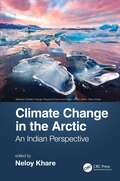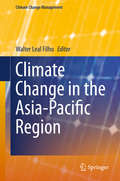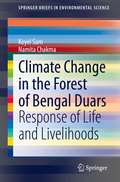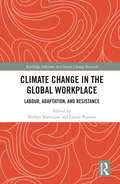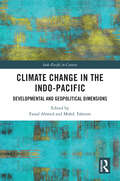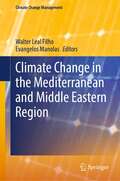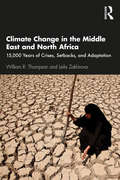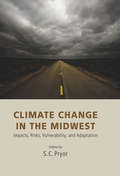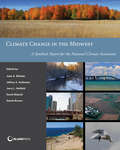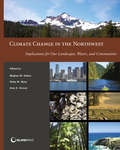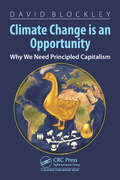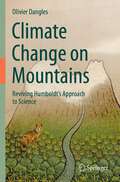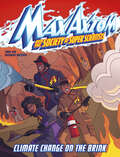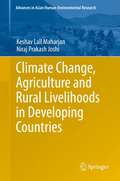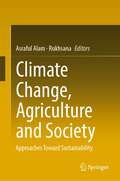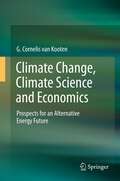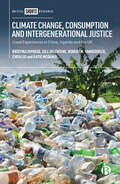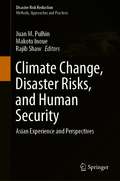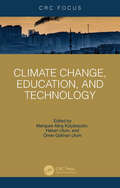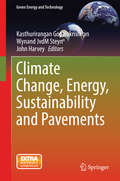- Table View
- List View
Climate Change in the Arctic: An Indian Perspective
by Neloy KhareThe Arctic, in the polar region, the northernmost part of Earth, is the hotspot for climate change assessments and the sensitive barometer of global climate variability. This book includes the scientific observations in the Arctic region’s climate and the results obtained by scientists at the Indian Arctic station Himadri over the past decade. Designed and structured to incorporate multi-dimensional climate change research output, it is a significant contribution toward understanding, among other issues, the role of persistent organic pollutants and mercury, as well as the increase of carbon monoxide during ozone reduction in the Arctic. Features include: Highlights the achievements of climate change research in the Arctic region Includes case studies of scientists in the Arctic and their significant achievements through the Indian research base Himadri Provides a thorough review of palaeoclimate change studies, the impact of climate change on biotic components and the impact of climate change on abiotic components Provides specific details on the study of ozone depletion phenomenon over the Arctic region Covers a wide range of research contributions Details sea ice variability in the context of global warming over the Arctic region Connects seismogenesis with the climate change in the Arctic region This book will be an important read for researchers, students and all interested professionals.
Climate Change in the Asia-Pacific Region (Climate Change Management)
by Walter Leal FilhoThis book investigates the socio-economic impacts of Climate Change in the Asia-Pacific region. The authors put forward a strategy and action plans that can enhance the capacity of government agencies and non-governmental organizations to reduce the negative impacts of climate change. The needs and interests of critical and neglected groups are highlighted throughout the book, alongside the need for improving knowledge management on climate change. The case studies presented offer regional analyses for countries such as Australia, Bangladesh, China, Fiji, India, Mongolia, Nepal and the Philippines and cover issues such as livelihood vulnerability and displacement, climate migration, macroeconomic impacts, urban environmental governance and disaster management.
Climate Change in the Forest of Bengal Duars: Response of Life and Livelihoods (SpringerBriefs in Environmental Science)
by Koyel Sam Namita ChakmaThis book focuses on more than 100 years of climatic oscillation in Bengal Duars, a unique foothill landscape of the Eastern Himalaya, to discuss the dynamics of life and livelihoods of forest dependent communities towards climate change related impacts. The authors describe the struggles the people of this region face, including climate vulnerability, displacement, migration, and human-animal conflict, and provides a unique and comprehensive analysis of the interconnection between perceptions and responses of forest villagers for survival and adaptation to climate change. The book presents advanced quantitative methods and field-based studies applied in the region to help researchers and policy makers comprehend and measure potential and actual adaptation attitudes of the villagers, while also understanding the present challenges, risk patterns, and potential impacts climate change has on the natural environment and community life. The book will additionally be of interest to students and researchers in geography, forestry, ecology and environmental science.
Climate Change in the Global Workplace: Labour, Adaptation and Resistance (Routledge Advances in Climate Change Research)
by Nithya Natarajan; Laurie ParsonsThis book offers a timely exploration of how climate change manifests in the global workplace. It draws together accounts of workers, their work, and the politics of resistance in order to enable us to better understand how the impacts of climate change are structured by the economic and social processes of labour. Focusing on nine empirically grounded cases of labour under climate change, this volume links the tools and methods of critical labour studies to key debates over climate change adaptation and mitigation in order to highlight the active nature of struggles in the climate-impacted workplace. Spanning cases including commercial agriculture in Turkey, labour unions in the UK, and brick kilns in Cambodia, this collection offers a novel lens on the changing climate, showing how both the impacts of climate change and adaptations to it emerge through the prism of working lives. Drawing together scholars from anthropology, political economy, geography, and development studies, this book will be of great interest to students and scholars of climate change adaptation, labour studies, and environmental justice. More generally, it will be of interest to anybody seeking to understand how the changing climate is changing the terms, conditions, and politics of the global workplace.
Climate Change in the Himalayas
by G. B. Pant P. Pradeep Kumar Jayashree V. Revadekar Narendra SinghThis book analyzes the issues associated with climate change in the Himalayas. The purpose of choosing the Himalayas as a focus is because it is a particularly fragile mountain system, highly sensitive to climate change impacts, and it contains one of the largest human populations affected by climate change. The book provides extensive data and information regarding the climate history of the Himalayas, and the current effects of climate change on Himalayan weather systems, and on human and animal populations in the region. The book begins with an overview of global climate change with discussions of data trends and international initiatives, then segues into a history of climate changes and weather trends in the Himalayas. Weather systems of the Himalayas, both past and current, are analyzed and detailed through climate models, seasonal observations of weather fronts, and overviews of various climate scenarios. The book then discusses climate change impacts and signat ures specific to the Central Himalayan region, where the largest effects of impacts are observed. Readers will discover analysis presented on water resources, meteorological changes, biodiversity, agriculture and human health along with perspectives of management and policy. This book will appeal to researchers studying climate science, climatology, environmental scientists and policymakers.
Climate Change in the Indo-Pacific: Developmental and Geopolitical Dimensions (Indo-Pacific in Context)
by Faisal Ahmed and Mohd. FaheemThis book explores multifarious policy dimensions relevant to climate change and its associated vulnerabilities in the Indo-Pacific region.The essays in the volume focus on:• Climate resilience in terms of policy implementation at the local, national, and regional levels in Asia-Pacific;• Understanding climate change through the lens of non-traditional security;• Assesses geo-economic and geopolitical impacts and adaptation strategies;• Examines issues of climate refugees and migration.The volume will be of great interest to scholars and researchers of politics, public policy, environment and sustainability studies, climate action and Indo-Pacific studies.
Climate Change in the Mediterranean and Middle Eastern Region (Climate Change Management)
by Walter Leal Filho Evangelos ManolasThis book serves the purpose of showcasing some of the works in respect of applied research, field projects, and best practice to foster climate change adaptation across the region.Climate change is having a much greater impact in the Mediterranean than the global average. In the Paris Climate Agreement, the UN member states pledged to stop global warming at well below two degrees, if possible at 1.5 degrees. This mark, which is expected elsewhere only for 2030 to 2050, has already been reached in the region. The situation could worsen in the coming years if the global community does not limit its emissions.The above state of affairs illustrates the need for a better and more holistic understanding of how climate change affects countries in the Mediterranean region on the one hand, but also on the many problems it faces on the other, which prevent adaptation efforts. There is also a perceived need to showcase successful examples of how to duly address and manage the many social, economic, and political problems posed by climate change in the region, in order to replicate and even upscale the successful approaches used.It is against this background that the book "Climate Change in the Mediterranean and Middle Eastern Region" has been produced. It contains papers prepared by scholars, practitioners, and members of governmental agencies, undertaking research and/or executing climate change projects, and working across the region.
Climate Change in the Middle East and North Africa: 15,000 Years of Crises, Setbacks, and Adaptation
by William R. Thompson Leila ZakhirovaEnvironmental factors in the Middle East and North Africa (MENA) have played a crucial role in the historical and social development of the region. The book delves into a broad set of historical literature from the past 15,000 years that neglected to consider environmental factors to their full effect. Beyond the broad historic analysis, the chapters derive conclusions for today’s debate on whether climate change leads to more social conflict and violence. Introducing a theoretical framework focused on adaptive cycling, this book probes and refines the role of climate in ancient and modern political-economic systems in the MENA region. It also underscores just how bad the 21st-century environment may become thanks to global warming. While the MENA region may not survive the latest onslaught of deteriorating climate, there is also some interest in how a region that once led the world in introducing all sorts of innovations thousands of years ago has evolved into a contemporary setting characterized by traditional conservatism, poverty, and incessant strife. Emphasizing regional dynamics, the book's central question deals with the role of climate change in the rise and decline of the MENA region. The book will be a key resource to students and readers interested in global warming, including academics and policymakers.
Climate Change in the Midwest
by Sara C. PryorThe research presented in this volume focuses on identifying and quantifying the major vulnerabilities to climate change in the Midwestern United States. By providing state-of-the-art spatially disaggregated information regarding the historical, current, and possible future climate within the region, the contributors assess the risks and susceptibility of the critical socio-economic and environmental systems. Key sectors discussed are agriculture, human health, water, energy and infrastructure, and the vulnerabilities that may be amplified under current climate trajectories. The book also considers the challenges and opportunities to develop local and regional strategies for addressing the risks posed by climate change in the context of developing an integrative policy for the region.
Climate Change in the Midwest: A Synthesis Report for the National Climate Assessment (NCA Regional Input Reports)
by Daniel Brown Jerry L. Hatfield Julie A. Winkler Jeffrey A. Andresen BidwellDeveloped to inform the 2013 National Climate Assessment, and a landmark study in terms of its breadth and depth of coverage and conducted under the auspices of the U.S. Global Change Research Program, Climate Change in the Midwest examines the known effects and relationships of climate change variables on the eight states that make up the region. This state of the art assessment comes from a broad range of experts in academia, private industry, state and local governments, NGOs, professional societies, and impacted communities. It highlights past climate trends, projected climate change and vulnerabilities, and impacts to specific sectors. Rich in science and case studies, it examines the latest climate change impacts, scenarios, vulnerabilities, and adaptive capacity and offers decision makers and stakeholders a substantial basis from which to make informed choices that will affect the well-being of the region's inhabitants in the decades to come.
Climate Change in the Northwest: Implications for Our Landscapes, Waters, and Communities (NCA Regional Input Reports)
by Meghan M. Dalton Philip W. Mote Amy K. SnoverClimate Change in the Northwest: Implications for Our Landscapes, Waters, and Communities is aimed at assessing the state of knowledge about key climate impacts and consequences to various sectors and communities in the northwest United States. It draws on a wealth of peer-reviewed literature, earlier state-level assessment reports conducted for Washington (2009) and Oregon (2010), as well as a risk-framing workshop. As an assessment, it aims to be representative (though not exhaustive) of the key climate change issues as reflected in the growing body of Northwest climate change science, impacts, and adaptation literature now available. This report will serve as an updated resource for scientists, stakeholders, decision makers, students, and community members interested in understanding and preparing for climate change impacts on Oregon, Washington, and Idaho. This more detailed, foundational report is intended to support the key findings presented in the Northwest chapter of the Third National Climate Assessment.
Climate Change is an Opportunity: Why We Need Principled Capitalism
by David BlockleyWe have an imperative, as never before, to change our ways. Climate change is presenting the entire human race with its greatest ever existential challenge. Like many I feel a growing sense of looming disaster. Yes, we are making some progress, but past agreements are not delivering. In this book I put a case for a new form of principled capitalism based on moral principles rather than utility and profit. I propose ten pillars that include systems thinking as citizens of the world and embracing Modern Monetary theory to guide decisions about macroeconomics and national debt.
Climate Change on Mountains: Reviving Humboldt’s Approach to Science
by Olivier DanglesThe world is warming up rapidly and this change is most noticeable in mountains with already observable consequences on flora and fauna. This book presents concepts, methodologies and major achievements of recent research in climate change ecology in mountains by placing this research in a historical perspective, that of travelers and naturalists of the Romantic era, and first of all Alexander von Humboldt.There is now a renewed interest, both in academia and beyond, in Humboldt, his writings and his view of nature. But how can we actually make use of his writings? How can we put his philosophy into practice? How can we still learn from past scientific figures and do a better science today? In this book, the author presents how it is possible to succeed in modern science by returning to sources, by renewing the tradition of past polymaths such as Humboldt, and by having a fully humanistic approach in science. He illustrates his point based on his 15-year experience in the study of the ecological effects of climate change in the tropical Andes, showing how he has incorporated approaches from other disciplines, from different branches of science, from history and the arts to achieve a more comprehensive view of his scientific field. Alongside hard data, discoveries by past naturalists build our understanding of the world but appealing to our emotions makes us want to understand it. In the author’s view this is a productive and enjoyable way of doing science that speaks to our humanity and also increases our knowledge about nature. This academic cross-over book appeals to a broad audience of students, scientists or, supported by attractive illustrations, to anyone interested in the adventure or making of science, but not necessarily with a scientific background.
Climate Change on the Brink: A Max Axiom Super Scientist Adventure (Max Axiom and the Society of Super Scientists)
by Carol KimEarth’s climate is changing. Heat waves and droughts are more common and more severe. Powerful hurricanes cause widespread damage. And polar regions are warming fast, causing even more problems around the world. Why is this happening? In this nonfiction graphic novel, Max Axiom and the Society of Super Scientists go on an exciting, fact-filled adventure that will help young readers learn about the causes and effects of climate change and learn ways that they can make a difference.
Climate Change, Adaptation and Gender: Policy, Practice and Methodological Underpinnings (CABI Climate Change Series #17)
by Dr Mamta Mehar Professor Narayan PrasadThis book offers a wide, in-depth study of the gender-climate change-agriculture nexus. The crux of understanding these connections comprises gender equality and tools to measure gender discrimination, the evolution of the concept of gender inclusiveness and its concerns; and the need to address the same by formulating gender-inclusive policymaking. Despite the fact that more than 50 years have elapsed since gender concerns were included in explorations of this nexus, there is still ambiguity around the foundations, connections, and approaches for planning gender-inclusive climate policies. This book aims to clear that ambiguity by: · Being the first to explore exclusively this issue in detail. · Revealing how and why consideration of gender is so important for understanding how climate change impacts rural communities and agricultural systems globally. · Exploring every dimension of climate change (including belief systems and perceptions, knowledge, experience, coping strategies, adaptation, and mitigation strategies) and linking it to gender. It includes new theoretical and methodological approaches that go far beyond the household as the unit of analysis (using various approaches, including intersectional analysis). The book not only throws light on major themes of research, but also covers different methodologies ranging from review methods to mathematical models, conceptual frameworks and empirical analysis. It will be of wide interest to students, scholars, and researchers in gender studies, agriculture, climate change and rural development research, and also to practitioners, extension workers, and planners designing new climate-resilient practices.
Climate Change, Agriculture and Rural Livelihoods in Developing Countries (Advances in Asian Human-Environmental Research)
by Keshav Lall Maharjan Niraj Prakash JoshiThis book is about climate change and its relation to agriculture and rural livelihoods. It starts by providing a basic understanding of climate change science followed by the relation of climate change to agriculture, the impact of which is discussed based on the particular impact of climate change on plant and animal physiology. The book further discusses the inclusion of the agriculture sector in various international climate change negotiations. It also reviews the cost and opportunities for agricultural projects through international climate change regimes, specifically the Clean Development Mechanism under the Kyoto Protocol. With this background, the book finally proceeds to an explanation of the methodologies used to assess the impact of climate change on agriculture and empirically discusses its impact on agriculture and rural livelihoods in Nepal.
Climate Change, Agriculture and Society: Approaches Toward Sustainability
by Rukhsana Asraful AlamThis book discusses emerging contexts of global warming and climate change, agricultural vulnerability and adaptation from local to global scale. Climate change, resilience in relation to agriculture and livelihoods and multi-dimensionality of various approaches are clearly taken into account by providing studies and perspectives on various methods and scales based on natural science to social science frameworks. This edited work contains chapters that are interdisciplinary, covering climate change, agriculture vulnerability, disaster impact, productivity efficiency, food security, livelihood resilience, land degradation, sustainability, in terms of plan and perform for transformation, sustainability and adaptation, including philosophy, change and economics, as well as the natural sciences. This book addresses the sustainable development goals to reduce the adverse impacts on agricultural productivity brought on by climate change and its adaptation and disaster risk reduction in developing and developed nations. Some of the assessed challenges include soil erosion, land use conversion, natural resource mismanagement, crop productivity decline and economic stagnation. This book covers important issues in the production and consumption of food in the past and present periods, agriculture, livelihood, and climate change, disaster risk management and society. All of these are under the threat of ongoing climate change and significant challenges to livelihood sustainability. The book is arranged into five broad sections: each part will cover a set of chapters dealing with a particular issue of the climate change, agriculture and society: approach toward sustainability. This book aims to attract attention of students, researchers, academician, policymakers and other inquisitive readers interested in different aspects of climate change, agriculture, livelihood and sustainability, particularly at local to global context.
Climate Change, Capitalism, and Corporations
by Christopher WrightClimate change is one of the greatest threats facing humanity, a definitive manifestation of the well-worn links between progress and devastation. This book explores the complex relationship that the corporate world has with climate change and examines the central role of corporations in shaping political and social responses to the climate crisis. The principal message of the book is that despite the need for dramatic economic and political change, corporate capitalism continues to rely on the maintenance of 'business as usual'. The authors explore the different processes through which corporations engage with climate change. Key discussion points include climate change as business risk, corporate climate politics, the role of justification and compromise, and managerial identity and emotional reactions to climate change. Written for researchers and graduate students, this book moves beyond descriptive and normative approaches to provide a sociologically and critically informed theory of corporate responses to climate change.
Climate Change, Climate Science and Economics: Prospects for an Alternative Energy Future
by G. Cornelis van KootenThis volume enables readers to understand the complexity associated with climate change policy and the science behind it. For example, the author describes the criticism and defense of the widely known "hockey stick" temperature graph derived from combining instrumental data and proxy temperature indications using tree ring, ice core and other paleoclimatic data. Readers will also learn that global warming cannot easily be avoided by reducing CO2 and other greenhouse gas emissions in rich countries. Not only is emissions reduction extremely difficult in rich countries, but demands such as the UN mandate to improve the lives of the poorest global citizens cannot be satisfied without significantly increasing global energy use, and CO2 emissions. Therefore, the author asserts that climate engineering and adaptation are preferable to mitigation, particularly since the science is less than adequate for making firm statements about the Earth's future climate. Readers will also learn that global warming cannot easily be avoided by reducing CO2 and other greenhouse gas emissions in rich countries. Not only is emissions reduction extremely difficult in rich countries, but demands such as the UN mandate to improve the lives of the poorest global citizens cannot be satisfied without significantly increasing global energy use, and CO2 emissions. Therefore, the author asserts that climate engineering and adaptation are preferable to mitigation, particularly since the science is less than adequate for making firm statements about the Earth's future climate.
Climate Change, Consumption and Intergenerational Justice: Lived Experiences in China, Uganda and the UK
by Gill Valentine Kristina DiproseThe United Nations 2030 Agenda for Sustainable Development makes climate change and responsible consumption key priorities for both industrialized and emerging economies. Moving beyond the Global North, this book uses innovative cross-national and cross-generational research with urban residents in China and Uganda, as well as the UK, to illuminate international debates about building sustainable societies and to examine how different cultures think about past, present and future responsibility for climate change. <p><p> The authors explore to what extent different nations see climate change as a domestic issue, whilst looking at local explanatory and blame narratives to consider profound questions of justice between those nations that are more and less responsible for, and vulnerable to, climate change.
Climate Change, Disaster Risk, and the Urban Poor
by Judy L. BakerPoor people living in slums are at particularly high risk from the impacts of climate change and natural hazards. They live on the most vulnerable lands within cities, typically areas that are deemed undesirable by others and are thus affordable. Residents are exposed to the impacts of landslides, sea-level rise, flooding, and other hazards. Exposure to risk is exacerbated by overcrowded living conditions, lack of adequate infrastructure and services, unsafe housing, inadequate nutrition, and poor health. These conditions can turn a natural hazard or change in climate into a disaster, and result in the loss of basic services, damage or destruction to homes, loss of livelihoods, malnutrition, disease, disability, and loss of life. This study analyzes the key challenges facing the urban poor given the risks associated with climate change and disasters, particularly with regard to the delivery of basic services, and identifies strategies and financing opportunities for addressing these risks. Several key findings emerge from the study and provide guidance for addressing risk: * The urban poor are on the front line. The poor are particularly vulnerable to climate change and natural hazards due to where they live within cities, and the lack of reliable basic services. * City governments are the drivers for addressing risks. Local governments play a vital role in providing basic services which are critical to improving the resilience of the urban poor. * City officials build resilience by mainstreaming risk reduction into urban management. Climate change adaptation and disaster risk reduction can be best addressed and sustained over time through integration with existing urban planning and management practices. * Significant financial support is needed. Local governments need to leverage existing and new resources to meet the shortfalls in service delivery and basic infrastructure adaptation.
Climate Change, Disaster Risks, and Human Security: Asian Experience and Perspectives (Disaster Risk Reduction)
by Rajib Shaw Makoto Inoue Juan M. PulhinThis book explores how climate change and disaster risks threaten human security in Asia. Climate change and disaster risks have emerged as major human security challenges in the twenty-first century, and are an imminent “threat multiplier” with the potential to harm the vital core of human life and curtail people’s freedom and ability to live with dignity. Climate change and disaster risks undermine the security of individuals, communities, nations, and the world, considering the increasing trend in the frequency and magnitude of hydro-meteorological disasters and the projections on their future adverse impacts. Despite recent advances in the literature, there is still a major gap in understanding the relationship and linkages between climate change, disaster risks, and human security, particularly as gleaned from the Asian experience. Asia is the world’s most vulnerable region in terms of the quantity and magnitude of impacts from various forms of disaster. At the same time, it has developed a number of innovative responses to address those risks, offering a wealth of experience. Exploring and capitalizing on the Asian perspective, this book provides valuable resource material for students, academics, researchers, policymakers, and development practitioners working in these areas.
Climate Change, Disaster and Adaptations: Contextualising Human Responses to Ecological Change (Sustainable Development Goals Series)
by Azizur Rahman Siddiqui Avijit SahayThis volume examines how local communities respond and adapt to ecological changes and disasters resulting from climate change. The main aim of the book is to understand the range of human responses to ecological change and to contextualise the reasons for adopting any particular adaptive strategy by a community. Through the help of specific case studies presented as individual chapters, the book aims to find out whether adaptation due to environmental stress is an individual decision and, therefore, is an isolated phenomenon, or if resilience and adaptation are part of the same action paradigm of society as a whole in response to environmental change. Of particular interest are the case studies of climate change or disasters that have rendered the site unsuitable for the return of its community at present, and thus necessitated the relocation of such communities to new locations. The case studies in the book focus on regions in India, but cover different parts of the world as well, and address concepts of resilience, vulnerability, risk, adaptation, and mitigation. The book will be useful for students and researchers in the fields of geography, disaster management, environmental science, and anthropology.
Climate Change, Education, and Technology
by Ömer Gökhan Ulum Hakan Ulum Menşure Alkış KüçükaydınThe climate change crisis is the greatest challenge humanity has ever confronted. As human activities are the most significant cause for this crisis, the solution must come from within humanity. While global movements—NGOs, universities, municipal governments, etc.—are doing their part to combat the crisis, the role of education and technology cannot be emphasized enough. Education is necessary to enhance awareness, especially among the youth, generate solutions, and implement them. Technology contributes to this process by creating climate change-fighting solutions, accumulating and analysing data, and providing energy efficiency. Technology also enables the monitoring of the climate, the mitigation of its effects, and the enhancement of the environment. Therefore, climate change, education, and the use of technology should be addressed as a unit. In this volume, the authors integrate climate change, education, and technological applications.This book is comprehensive and offers readers a variety of perspectives, encouraging the generation of novel and inventive ideas. The collaboration of authors from various disciplines to address the issue brings about novel and intriguing perspectives.
Climate Change, Energy, Sustainability and Pavements (Green Energy and Technology)
by John Harvey Kasthurirangan Gopalakrishnan Wynand Jvdm SteynClimate change, energy production and consumption, and the need to improve the sustainability of all aspects of human activity are key inter-related issues for which solutions must be found and implemented quickly and efficiently. To be successfully implemented, solutions must recognize the rapidly changing socio-techno-political environment and multi-dimensional constraints presented by today's interconnected world. As part of this global effort, considerations of climate change impacts, energy demands, and incorporation of sustainability concepts have increasing importance in the design, construction, and maintenance of highway and airport pavement systems. To prepare the human capacity to develop and implement these solutions, many educators, policy-makers and practitioners have stressed the paramount importance of formally incorporating sustainability concepts in the civil engineering curriculum to educate and train future civil engineers well-equipped to address our current and future sustainability challenges. This book will prove a valuable resource in the hands of researchers, educators and future engineering leaders, most of whom will be working in multidisciplinary environments to address a host of next-generation sustainable transportation infrastructure challenges. "This book proposes a broad detailed overview of the actual scientific knowledge about pavements linked to climate change, energy and sustainability at the international level in an original multidimensional/multi-effects way. By the end, the reader will be aware of the whole global issues to care about for various pavement technical features around the world, among which the implications of modelling including data collection, challenging resources saving and infrastructures services optimisation. This is a complete and varied work, rare in the domain. " Dr. Agnes Jullien Research Director Director of Environmental, Development, Safety and Eco-Design Laboratory (EASE) Department of Development, Mobility and Environment Ifsttar Centre de Nantes Cedex- France "An excellent compilation of latest developments in the field of sustainable pavements. The chapter topics have been carefully chosen and are very well-organized with the intention of equipping the reader with the state-of-the-art knowledge on all aspects of pavement sustainability. Topics covered include pavement Life Cycle Analysis (LCA), pervious pavements, cool pavements, photocatalytic pavements, energy harvesting pavements, etc. which will all be of significant interest to students, researchers, and practitioners of pavement engineering. This book will no doubt serve as an excellent reference on the topic of sustainable pavements. " Dr. Wei-Hsing Huang Editor-in-Chief of International Journal of Pavement Research and Technology (IJPRT) and Professor of Civil Engineering National Central University Taiwan
